1965 Monaco Grand Prix race report: Hill fights back
Graham Hill overcomes an early spin to fight back through the field and win his third Monaco Grand Prix
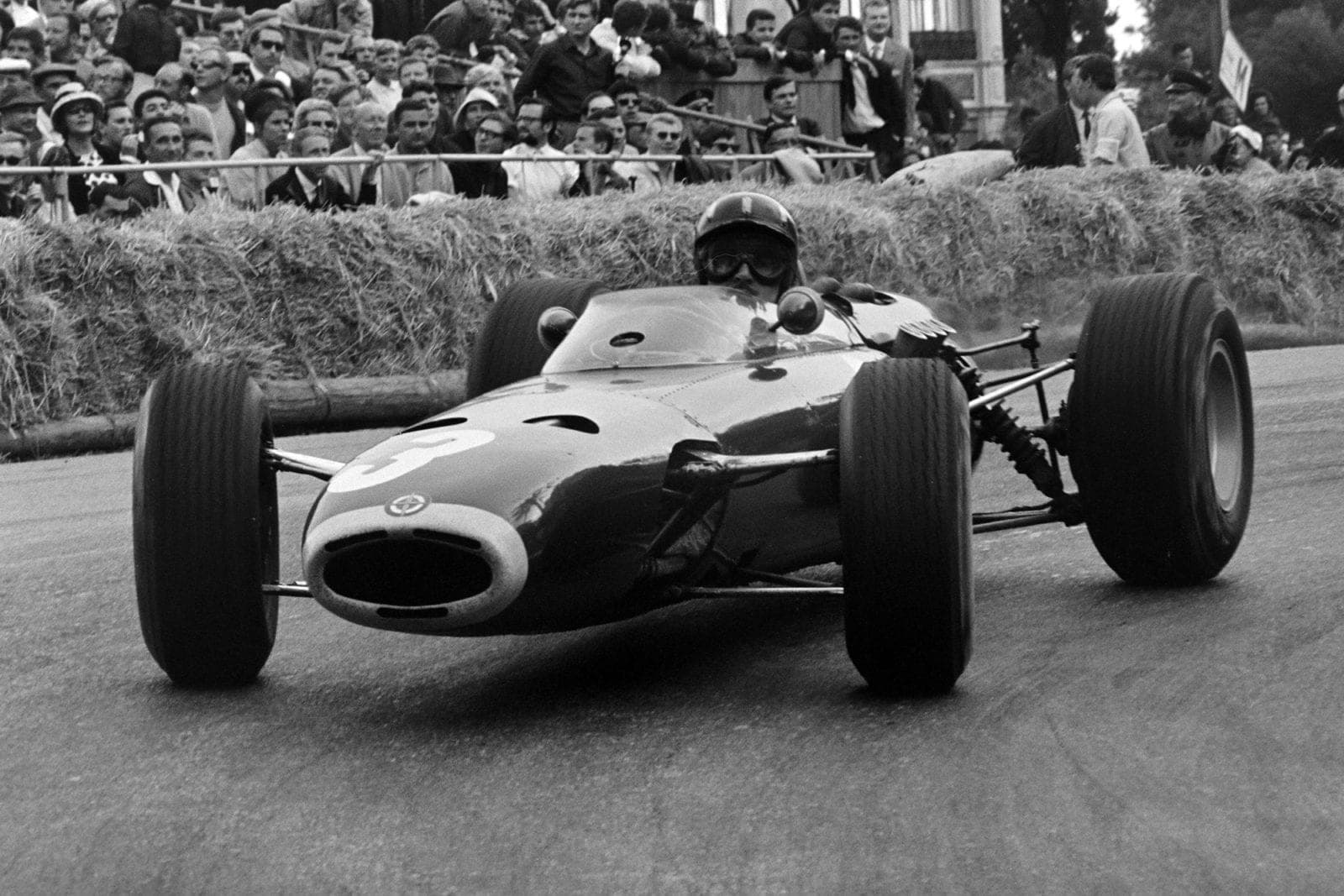
Hill took his third Monaco win
Motorsport Images
This year the Indianapolis race, which has now become of great interest to Europeans, was held the day after the Monaco Grand Prix, so there was no possibility of any drivers competing in both events, as in past years. Consequently Jim Clark and Dan Gurney did not enter for the Monaco race and Team Lotus proposed to replace Clark with Pedro Rodriguez and Brabham replaced Gurney with Denis Hulme.
With the starting grid limited to sixteen cars the organisers guaranteed certain places to each factory team, depending on their drivers’ results in the 1964 Championship, the remainder of the positions being decided by practice times. Team Lotus wanted guaranteed starts for Spence and Rodriguez, but the organisers would only guarantee one, so Team Lotus withdrew their entries and did not go to Monaco. This reduced the field to seventeen cars, so that the three practice periods only had to eliminate one car.
Qualifying
On Thursday afternoon there was one and a half hours of practice, during which everyone should have become adjusted to the circuit ready for the two shorter periods the following days. Just as the circuit was opened for practice the rain began to fall and got worse as the afternoon went on, so that only those drivers who were quick off the mark got anything like a reasonable lap time, the rest being impossibly slow in the soaking circuit. For a lot of people the problem was to keep all the cylinders working, for spray was getting everywhere and most of the entry sat despondently in the pits, but it was noticeable that number one works drivers Graham Hill and Surtees were splashing round pretty consistently.
The BRM team of Hill and Stewart had three cars at the circuit; all of the latest type with central exhaust system, and Ferrari had two V8 cars for Surtees and a flat 12-cylinder car for Bandini; Surtees having different types of Dunlop tyre on the two V8-cylinder cars.
Jack Brabham’s own car was fitted with a new four-valve-per-cylinder Coventry-Climax V8 engine, while Hulme had an earlier unit, as did the two works Coopers, driven by McLaren and Rindt. The Japanese Honda team were out in strength, having three cars at the pits for drivers Bucknum and Ginther, these cars being improved versions of last year’s car.
The rear suspension has been simplified and is now on the lines of a Lotus or Brabham and Dunlop have been discarded for brakes, wheels and tyres. Girling disc brakes are used, Honda alloy wheels and Goodyear tyres, while fuel tanks have been built in the sides of the cockpit giving a slightly fatter section. The transversely mounted 12-cylinder engine still uses Japanese fuel injection into the ports with a system of wires and pulleys to connect the throttle slides and the mixture strength control, while the battery has been moved within the wheelbase from its previous position on an outrigger behind the rear suspension.
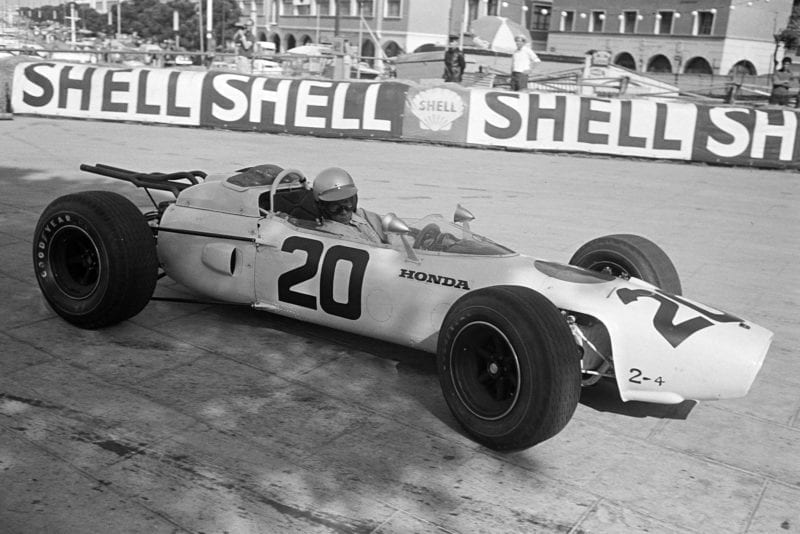
Ginther had moved over to Honda for 1965, partnering Bucknum
Motorsport Images
The non-factory entries consisted of Anderson with his Brabham-Climax V8 and Hawkins with Stoop’s Lotus 33-Climax V8, combined under the mantle of DW Racing Enterprises Ltd, both cars being painted green with a central white stripe. Gardner was driving the Willment Brabham-BRM V8 and Rob Walker’s team was his usual pair, Bonnier and Siffert. The Swedish driver was in the Brabham-Climax V8 and Siffert was making his re-entry to racing after his Goodwood crash, still suffering from a painful foot. His Brabham BRM V8 had to be completely rebuilt after the accident and was now virtually brand-new.
To complete the list Hailwood and Attwood had the Parnell team cars of ex-works Lotus 25 chassis with BRM V8 engines and Newland gearboxes. From a collection of bits and by fabricating many parts themselves the team had built up a third car to the same specification, to be used as a training car and a spare. With only seventeen entries there was not the usual panic and scrambling to qualify as there was only going to be one unfortunate driver.
Before breakfast on Friday morning there was an hour of practice and the weather was perfect, with dry roads and sunshine and everyone began to charge around to record good times for the two-by-two starting grid. The BRM team seemed to be fairly free of troubles or complication and it was noticeable how forceful Stewart’s driving was, his speed in jumping from one pedal to the other being outstanding. Into the Station hairpin he would be on the accelerator right to the last moment, and then well and truly on the brakes, whereas other drivers would back off the throttle progressively as they came down the hill. Out of the right-hander onto the sea front it was the same; no hesitation with stamping the throttle open, or with changing gear, the only question being whether the BRM would stand up to this sort of forceful driving.
Graham Hill was going equally fast, his power-sliding round the hairpins being a joy to watch, while Brabham was employing the same tactics the 32-valve Climax engine opening up splendidly out of the hairpins. Bandini was obviously in the same happy and uninhibited mood as Stewart, the flat 12 Ferrari engine going well, but Surtees was not completely happy and both his cars seemed fluffy on pick-up. The Hondas were clearly unsuited to the circuit, being all revs, and gears, both of which are undesirable at Monte Carlo and there was precious little time for them to re-adjust themselves.
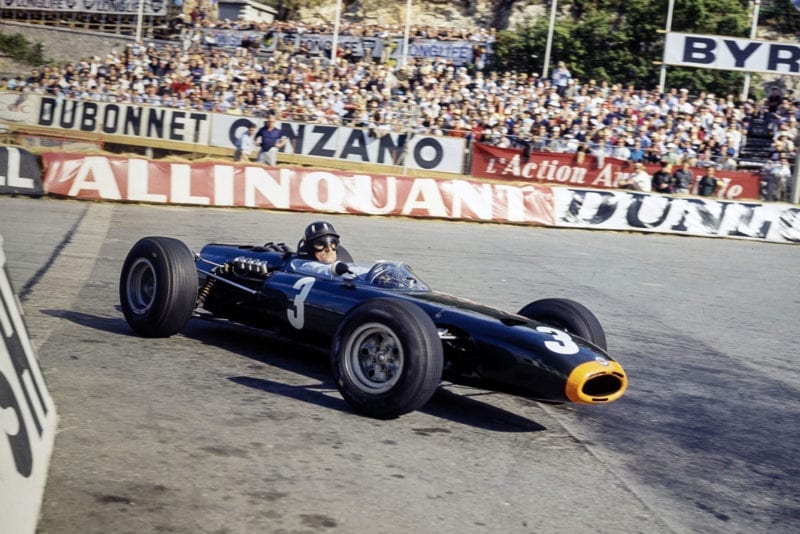
Hill took pole with a 0.3sec advantage over Brabham
Motorsport Images
With the good circuit conditions it was no surprise that lap times were well below previous years, the record standing at 1min 33.9sec to Graham Hill during last year’s race. Brabham improved on this and then Hill went one better, but right at the end of practice Stewart shook everyone, including himself, with a lap in 1min 32.9sec. Bandini was also well below the old record, and having seen these four at various points on the circuit it was no surprise that they were the fastest. Deceptive in his smoothness and appearance of not going fast was Attwood, who got down to 1min 34.5sec in the Parnell Lows-BRM V8, to lead all the non-factory entries and a number of works drivers as well. The Hondas were desperately slow and seldom running on twelve cylinders.
On Saturday afternoon there was the third and final practice session, again an all too short hour, and on the opening lan Bonnier’s car laid a stream of oil round the circuit, which did not help matters. It soon dried up and conditions were splendid, so that there was some pretty intensive motoring going on to get on the front of the narrow starting grid. The V8 Ferraris were nosy going well, but the flat 12 sounded even better and the 32-valve Climax engine almost split the car-drums when Brabham stood on the loud pedal. With Stewart holding pole position Graham Hill pulled out all the stops and had a real go, with the result that he got down to 1min 32.5sec and Brabham could see a possible win on the horizon so responded accordingly and clocked 1min 32.8sec, these two being on the front row of the grid.
“Hill and Brabham had obviously got their cars adjusted to a nicety for the special conditions that prevail at Monaco”
While other drivers were under-steering themselves off course at the Gasometer hairpin, or like Surtees and Bandini were rolling round in a neutral attitude; Hill and Brabham were flicking their cars into a tail slide in the approach to the hairpin, putting on opposite steering lock and applying full power almost front the apex, the others being a long way out of the corner before they could apply any power. These two had obviously got their cars adjusted to a nicety for the special conditions that prevail at Monaco.
Stewart did not improve on his previous time, but Bandini did, which got him ahead of his team-mate Suttees on the V8 Ferrari. The unobtrusive Attwood did it again; equalling the existing lap record, and making sixth fastest time. The Hondas were lucky to be firing on more than to cylinders due to injection problems and were bog-slow compared to the other works teams, though Rindt in the second works Cooper never got into the pace that McLaren set. In the final count it was Rindt who got left off the starting grid, for though he was faster than Ginther the Hondas were guaranteed too places irrespective of times.
Race
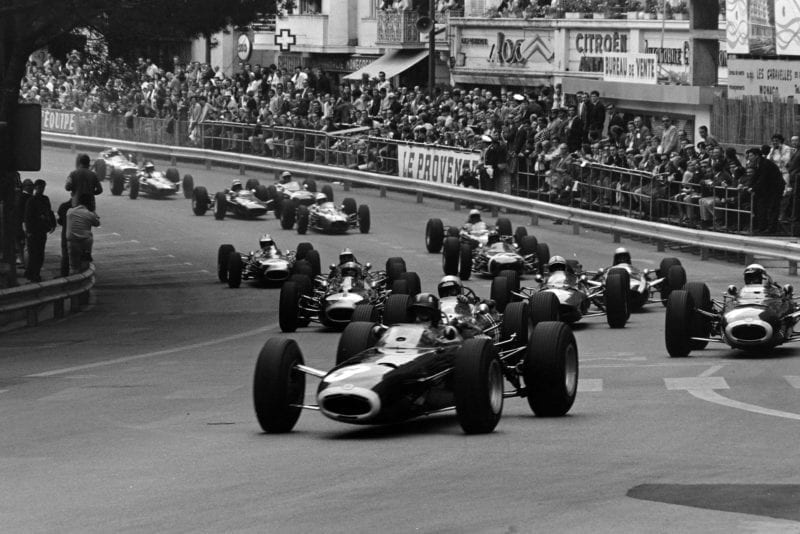
Hill leads the pack into the first corner
Motorsport Images
On Sunday afternoon the weather was awful for Monte Carlo, but perfect for racing. It was dry and cool with complete cloud cover so that the usually bright town took on a grey drab colour. After the arrival of the Prince and Princess of Monaco and a rather disorganised parade of historic cars and drivers, the 16 starters in the 100-lap Grand Prix lined up on the “dummy grid”.
At the given signal 15 of them moved forward to the proper starting grid, leaving Bucknum still trying to start his Honda engine which had got over-rich. The field roared away at the flag-fall and Bucknum joined in a few seconds later and straight away the two works BRMs dominated the scene, leading the two Ferraris and Brabham.
After everyone had gone by on the opening lap Ginther came into the pits with a broken universal joint in a drive shaft on his Honda. Graham Hill set a hard pace and Stewart sat in his slipstream, these two leaving everyone behind in a fine display of team power and strength.
Bandini led Surtees and Brabham was being harried by McLaren and Attwood; then came Anderson, Siffert and Hulme in a close bunch, Gardner and Hailwood together, Bonnier and Hawkins with Bucknum bringing up the rear. The two BRMs were pulling out nearly a second a lap over the two Ferraris and it looked like being a complete tour de force for the Bourne team.
Stewart was running almost too close to his team leader, but seemed determined to keep up with him, even after hitting a kerb with his nearside rear wheel on one lap. However, after 12 laps they lapped Bucknum and Stewart got held up by the Honda, so that once past there was a more reasonable gap between the two BRMs, their lead over the Ferraris increasing all the time, though Brabham was closing up on Suttees who seemed unable or unwilling to get in front of Bandini. There was a wisp of smoke coming from Brabham’s new Climax engine, due to a bolt coming out of the rev.-counter drive letting oil onto the hot engine and this later developed into serious trouble.
At 20 laps the order was Hill (BRM), Stewart (BRM), Banditti (Ferrari), Suttees (Ferrari), Brabham (Brabham), Anwood (Lotus), McLaren (Cooper), Hulme (Brabham), Anderson (Brabham), Gardner (Brabham), Siffert (Brabham), Bonnier (Brabham), Hawkins (Lotus) and Bucknum (Honda), the last two having been lapped, while Hailwood had retired with gearbox trouble.
Shortly after this Anderson was obviously in trouble and dropped back and on lap 25, as Hill came out of the tunnel. Anderson was going slowly towards the chicane leading on to the quay, a universal joint breaking up in a drive shaft. He was nursing the car back to the pits for repairs when Hill arrived at full bore and found Anderson’s car going slowly through the corner. There was no room for the two cars so Hill sensibly took to the escape road, but this meant that he had to get out and push the car back before he could rejoin the race.
Meanwhile, Stewart went by into the lead, followed by Bandini, Surtees and Brabham, so that Hill finished the lap in fifth place, with a very black and angry look on his face and his moustache fairly bristling. This little shuffle inspired Brabham and as Bonnier was lapped by the leading group the Australian nipped ahead of Surtees and began closing on Bandini, but the Italian was not impressed and took no notice of Brabham’s waving fist.
“Stewart had a comfortable lead, but he threw it all away by getting into a wild spin coming out of Ste Devote corner”
Stewart had a comfortable lead, but on lap 30 he threw it all away by getting into a wild spin coming out of Ste Devote corner and travelling backwards up the hill at high speed before coming to rest on the footpath. This let Bandini into the lead, so he obviously was not going to let Brabham past as easily as Surtees had done. Stewart rejoined the race just ahead of Graham Hill, and the two embarrassed and slightly angry BRM drivers were now 4th and 5th instead of 1st and 2nd.
Gardner dropped out with a broken engine bearer, which also ruined the BRM crankcase, and Bucknum retired the second Honda from last place when the gear-lever linkage became de-arranged. Anderson was repairing his drive shaft and Attwood was still leading McLaren and the rest of the field. On lap 34 Brabham took the lead from Bandini and went round the Gasometer hairpin in the biggest full-lock slide imaginable so that had the 12-cylinder Ferrari been able to out-accelerate the Brabham there would not have been room to get by.
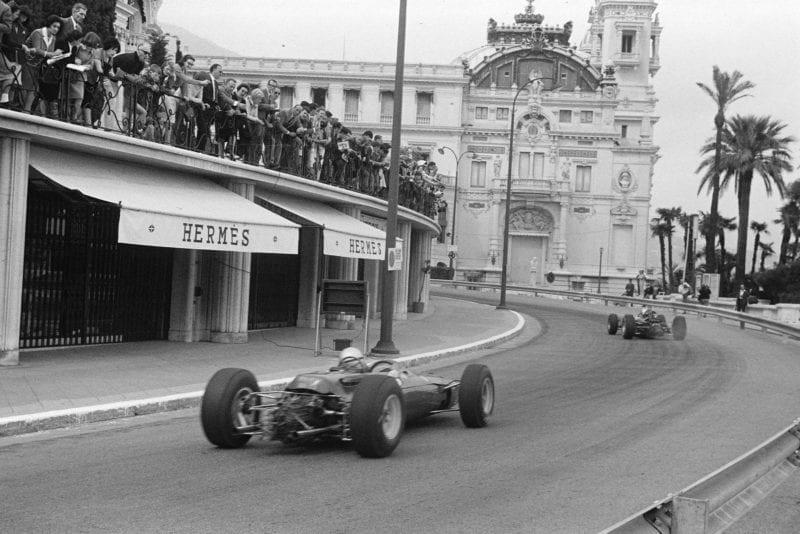
The crowds watch Bandini chase Brabham
Motorsport Images
Surtees seemed content to sit back in third place, even though Graham Hill was now wound up into a furious pace and was bearing down relentlessly on all and sundry, his young Scottish team-mate being the first victim. One look in the mirrors was enough and Stewart moved over and waved Hill through, making no attempt to try and keep up with him, for it was obvious that in the opening laps Hill had been taking things comfortably. It was a different story now, and when Surtees saw him coming up in his mirrors he made a bit of an effort to get by Bandini, but the young Italian was too busy hanging on to Brabham to take much notice of this.
Unbeknown to anyone Brabham was having a hard time, for the loose rev-counter drive had finally broken the cable so he was driving without knowing what rpm his engine was doing. Being in the lead he could not ease up, for he had the Ferraris and BRMs chasing him, and he tried to judge his 10,500rpm by ear when accelerating through the gears. For fifteen laps he did this, but without an instrument it was impossible not to over-rev, in the heat of the battle and finally the Climax engine succumbed and broke and Brabham coasted into the pits, letting Bandini back in the lead once more.
Hill was now pressing the two Ferraris very hard and Stewart was quite a way back. McLaren had got in front of Attwood again and they were 5th and 6th, with Hulme some way behind them and Siffert, Bonnier and Hawkins were still in, while Anderson had rejoined the race.
On lap 44 as Attwood braked for the Gasometer hairpin his left rear suspension broke and the wheel and brake came off so that his foot went down and hit the accelerator. The car shot forward and went straight up onto the straw bales, the driver being unhurt, but he was very lucky for he had gone straight across in front of McLaren’s Cooper that was just turning into the hairpin.
While the crowd and the Marshals were just getting over this flap Hulme arrived, about to lap Hawkins, and at the same time Bandini, Surtees and Hill arrived at the hairpin in a struggling bunch and for a moment there was complete chaos with cars all over the place. Nobody did anything silly and it all sorted itself out, but it was hair-raising to watch from close quarters. All this excitement and the race had not reached half-distance!
At the 50-lap mark Bandini still led in the 12-cylinder Ferrari, hotly pursued by Surtees in a V8 Ferrari and Hill had the nose of his BRM right on their tails. Stewart was a lonely 4th and McLaren was 5th and about to be lapped. Then came Hulme and Siffert, with Bonnier, Hawkins and Anderson bringing up the rear. Graham Hill was pressing relentlessly and on lap 53 Suttees could no longer keep him at bay and the BRM was between the two Ferraris.
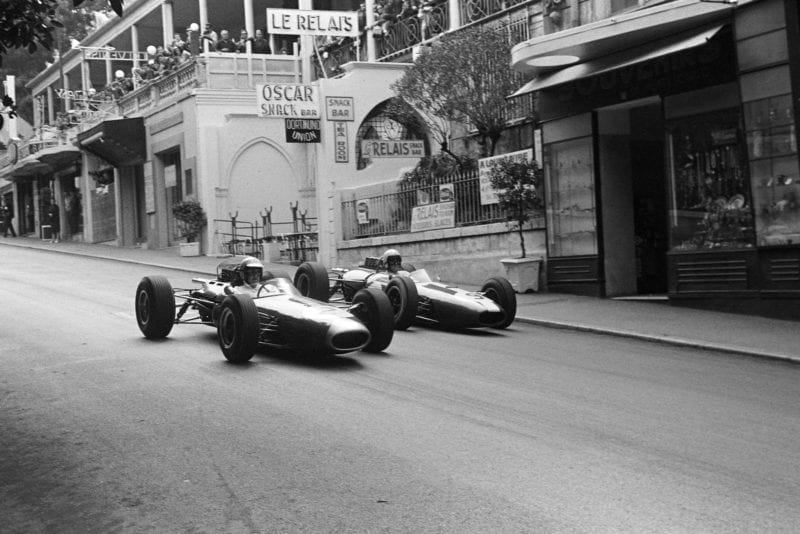
Hulme battles with Anderson
Motorsport Images
If Surtees had given up easily to Hill’s pressure Bandini had no intention of doing the same and he hung on to the lead splendidly, but by the determination in Hill’s driving it seemed unlikely that the Italian would keep up the pace, always assuming that the cars would stand the pace. Surtees made a few feeble attempts to worry Hill, but to no avail, and the BRM was right behind the 12-cylinder Ferrari, the driver waiting his chance to pounce.
On lap 64 as they braked for the Gasometer hairpin Hill looked all ready to take Bandini, and sure enough on the next lap, the BRM was in the lead, but Banditti didn’t give up and fought hard to stay with the BRM. No one could challenge Hill in the mood he was in and the BRM was going splendidly and it pulled away remorselessly from the two Ferraris. These three were fit: only ones in the race, the rest having been left far behind, and Hill had been lowering the lap record continuously.
Surtees now began to challenge Bandini and on lap 78 he chopped his way past his team-mate, which seemed a bit late in the day for such tactics. He obviously wasn’t going to make up anything on Hill for the BRM was going as well as ever and on lap 82 Hill set a new all-time lap record in 1min 31.7sec. Bandini now eased off and reduced his maximum rpm by 1,000, as there was a risk of running out of fuel having kept up such a searing pace for so long. At 1,000rpm below maximum the Ferrari engineers had calculated the fuel consumption during practice laps, compared to laps at maximum rpm and rather than risk running out or making a pit stop Bandini settled for third place and eased off.
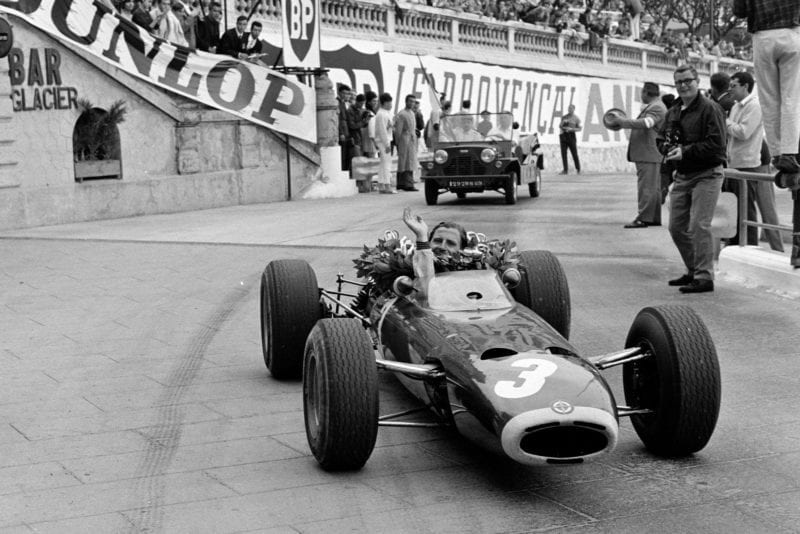
Hill soaks up the adulation after winning
Motorsport Images
At this point there was a bit of a furore at the chicane for Hawkins struck the wooden barrier at the entry and spun through the straw bales and over the edge of the quay and into the harbour. The Lotus sank to the bottom and the rugged Australian bobbed to the surface and struck out for shore, while boats went to his rescue. Graham Hill stayed firmly in the lead and though Surtees was able to keep the gap constant at a few seconds, showing that there was not much to choose between the two cars, he could not close the gap.
“Hawkins struck the wooden barrier at the entry and spun through the straw bales and over the edge of the quay and into the harbour”
Bandini dropped well back, conserving fuel, and Stewart was nearly a whole lap down, in 4th place. McLaren was still a steady 5th and Hulme had to stop at the pits as his right rear wheel was wobbling badly. Two of the four fixing studs had sheared right off so he sat and waited for Hill to start his last lap before he set off slowly to drive round to the finish.
Hill almost lapped his team-mate and as he started his last lap Surtees was seen coasting down the straight behind the pits, he coaxed the Ferrari round to the finishing line, to complete his 99th lap but there it expired, out of petrol, the injection system being completely dry. Graham Hill completed his 100th lap of the tortuous city circuit, a very tired but happy man, having driven one of the best races of his career to win the Monaco GP for the third year running. Bandini came in second, followed by Stewart, while a sweat-soaked and bedraggled-looking Surtees was an unhappy 4th.
Monte Mutters
- The Ferraris used fibreglass nose cowlings at first, but the 12-cylinder showed signs of overheating so a shortened aluminium one was used in the race; with a larger opening, the V8 retaining its fibreglass nose.
- There was some discussion as to whether Hawkins used an Australian crawl or an American crawl to return to the edge of the harbour after his dive. Whatever it was it was an impressive and powerful stroke. Exactly ten years ago Ascari went in at the same place in a Lancia.
- Anyone who thinks that a Ferrari BRM battle next year, without Lotus, Brabham and Cooper will be dull, should have been at Monte Carlo.
- It must be admitted that two of the fastest drivers in the world, Clark and Gurney, were not in the race.
Monaco F3
As has become traditional Saturday saw a Formula Three event on the famous street circuit, the huge entry being divided into two heats, the first 11 from each race going into the final. The first Heat saw Mairesse in an Alpine-Renault jump into the lead, but the British F3 regulars gradually wore him down with their more powerful Ford engines. In the second Heat Pike (Brabham-Ford) set a very fast and smooth pace until Bondurant in a Tyrell Cooper-BMC got by Revson into second place and began to close up on the leader. With only a lap and a half to go Pike spun and Bondurant struck the Brabham, both cars being eliminated.
In the final Cardwell (Brabham-Ford) looked to have the race in his pocket when he spun on what he thought was water from a crashed French-owned Cooper, but in fact it was oil. This left the race to the American Revson in a Ron Harris Lotus-Ford and Irwin in a Merlyn, the former coming home the winner.
